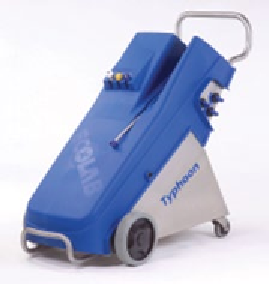Agriculture Reference
In-Depth Information
Manual cleaning
The agents may be applied manually, using cloth, mop,
squeegee, brush, green pad, etc. This is usually reserved
for small pieces of machinery or specific areas on larger
machinery that is non-waterproof or which needs dis-
mantling. It is labour intensive, can be dangerous when
used on sharp or heavy equipment and usually requires
safe, neutral chemicals. Detergents or sanitisers (combi-
nation detergents-disinfectants) may be used in this
way, but not normally disinfectants, as the repeated
immersion of the brush, pad or cloth in the solution after
contact with the surface would tend to reduce the disin-
fectant efficacy. Manual cleaning varies significantly
with the skill, commitment and time available to the
operator. While once common, it is not normally used
today for cleaning large plant areas.
Foam and disinfectant application equipment
This can be classified as mobile, centralised or satellite,
although there is some overlap. In addition, a satellite
foam application system is often part of the central rins-
ing system and additionally may facilitate disinfectant
application, described later.
Mobile foamers
may be based on air-driven pumps
with tank or venturi injectors attached to medium- or
high-pressure mobile washers. Advantages include lower
capital cost and versatility, supporting the use of differ-
ent hygiene chemicals in different areas. Disadvantages
include potential lack of chemical solution strength con-
trol, maintenance problems due to abuse/wear and tear
related to mobility, waste of unused chemical solution
and preparation and put-away time. The once popular
pressurised mobile tank is now subject to EU regulations
on the routine safety testing of pressure vessels and has
been largely replaced by the other technologies; exam-
ples are shown in Figure 5.4.
Centralised foam systems
are based on an automatic
chemical dilution tank and pump station, which pumps
the solution, as a liquid under low pressure, to numerous
outlets on a pipe work system throughout the factory.
Compressed air is injected into the outlet 'foam boxes' to
create the foam of the desired flow rate and air content.
Advantages include consistent chemical strength
throughout the plant with single-point control, no han-
dling of concentrated chemical and the avoidance of
drums of chemical in the factory production areas. The
elimination of preparation and put-away time is also of
benefit, saving about 30 minutes/operator/day. Chemical
usage is typically 10-20% lower than with tank mobiles
owing to reduction of waste. Disadvantages may include
requirement for a capital budget, deterioration of the
diluted detergent solution within the system due to water
Foam cleaning
This is the established method for COP consisting of
large or intricate equipment and is the standard proce-
dure in the vast majority of meat, poultry and other food
and beverage plants worldwide. A foam blanket, created
using a wide range of available equipment (see later), is
projected from a nozzle, and allowed to act on the soil
for typically 15-30 minutes, after which it is rinsed off
with the released deposits. Large areas such as floors,
walls, stands, conveyors and tables and intricate machin-
ery such as fillers, defeatherers, blackscrapers, etc. are
normally suitable for foam cleaning.
The foam itself is merely the carrier for the detergent
to enable it physically to function. The quality of the
foam may differ greatly, the best being creamy in con-
sistency rather than either too dry or too wet. The foam
should be applied as a thin, uniform layer. Coverage
rates are quite rapid and overall economy is good as
manual scrubbing is unnecessary and a little detergent
concentrate generates a lot of foam (up to 500-fold).
Only specially designed hygiene chemicals are suitable
for foam cleaning. The foam itself is created by a spe-
cial surfactant system that is present in the product in
addition to the actual cleaning components. Normal
detergents, which at first may appear quite foamy, will
give a rapidly collapsing foam and should not be used
for this purpose. Many speciality foam detergents and
foam sanitisers are available, from caustic through neu-
tral to acid, plus chlorine or quat, if needed. Recently
developed advanced foams give a much improved cling
to smooth vertical surfaces and can remain in contact
with complete coverage for 20-30 minutes or more.
Less well-designed formulations can often collapse
rapidly and slide off before the cleaning action is
complete.
(a)
(b)
Figure 5.4
Showing mobile unit for foam/disinfection/rinse
applications (a) and mobile unit for foam only applications
(b) (Reproduced with permission from Ecolab. © Ecolab).


